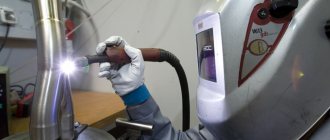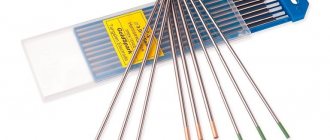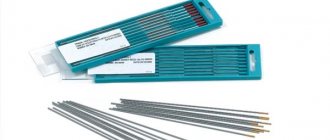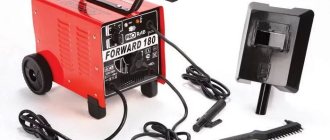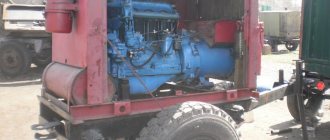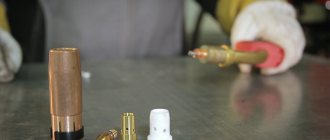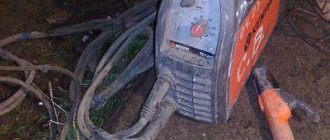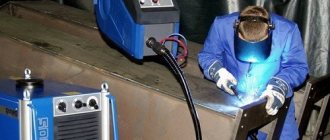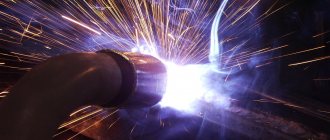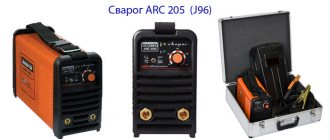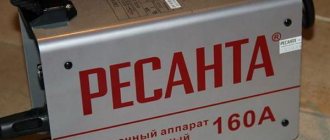What is argon welding
When using this method, heating is created using an electric arc. This method is called TIG welding. An inert gas is constantly supplied to the combustion site, preventing the oxidation of the metal. To obtain the desired conditions, you will need a current source that provides high current at low voltage.
The electrode does not melt during the welding process, which increases the accuracy and precision of the work. The ground wire is connected to the product. When you touch a live tungsten electrode to the workpiece, an arc is formed. Its length should be 2-5 mm. The arc temperature is 2000-5000 degrees. It is determined by the current strength provided by the welding machine.
Sometimes it is necessary to provide small transverse vibrations. This may be required when welding parts between which there is a slight gap or in cases where it is necessary to increase the width of the seam. Thin seams are welded by moving the electrode in a straight line. In the latter case, the connection becomes very neat.
Setting up the device before work Source naobzorah.ru
During operation, filler wire is sometimes used. The welder feeds it with his second hand. With its help, you can increase the height of the seam, give it a scaly appearance, and deposit additional metal.
Inert gas is supplied to the burner. Argon is used in most cases for this purpose. It displaces air from the working space, preventing metal oxidation processes, and also eliminating the formation of pores in the seam. Argon welding creates a beautiful and durable connection of parts.
The argon jet reduces the temperature of the burner nozzle and electrode, reducing their wear. When work is completed, the inert gas cools the weld structure.
Seam processing using argon welding Source fubag.ru
What criteria should you pay attention to when choosing a TIG welding machine?
- Current range. One of the important criteria when choosing a welding machine for argon arc welding. The narrow current range limits the possibilities when working with various metals. For example, a unit with a range of 5-230 A allows you to weld aluminum with a thickness of no more than 6.3 mm and stainless steel with a thickness of 0.6 mm. Welding aluminum parts requires more operating current than joining stainless steel workpieces. Welding equipment with a current range of 200 A does not allow working with aluminum, the thickness of which ranges from 3.2 to 4.6 mm. That is why the larger the range of operating current, the wider range of problems you can solve.
- Lowest operating current. When purchasing a welding machine for argon-arc welding, special attention should be paid to the stability of the arc at a current strength of less than 10 A. The ease of formation of the arc and its adjustment during further work depend on this parameter. Thin sheets of metal are welded using tungsten electrodes, but high frequencies and hot starts should be avoided. The “Hot Start” function does not ensure arc stability and deprives the welder of the ability to accurately control it during work. Also, when using this function, there is a high risk of burning through a thin metal sheet. It is important to ensure arc stability at the end of the welding process - at the completion of the seam. During the final stage of TIG welding, the amperage is usually reduced to fill the cavity at the end of the weld.
- Alternating and direct current. If you plan to weld not only stainless steel, but also aluminum, then you should choose welding equipment with alternating current (AC) and direct current (DC). For example, alternating current is used for welding magnesium and aluminum alloys (self-oxidizing metals), and direct current is used for copper and stainless steel. When working with alternating current, it changes from positive to negative. When connecting aluminum workpieces, a positive current cleans the metal surface of oxides, and a negative current causes the material to melt. When choosing a welding machine for argon arc welding, pay attention to whether it is possible to adjust the operating current balance from negative to positive and vice versa. This function will allow you to change the welding time with current of one polarity or another. Simply put, you will be able to control both the oxide purification time and the melting time.
- Easy to use. Most modern models on the market have clear control panels and are generally easy to operate. However, if you are going to work with aluminum, then the unit must have a pedal that regulates the current. The pedal will greatly facilitate the work process, allowing the welder to precisely reduce or increase the amperage as needed. Using a foot pedal, you can maintain a good speed of electrode conduction, resulting in an even seam with a constant profile. A smooth reduction in current at the end of welding ensures proper filling of the cavity. You can also find manual analogues for adjusting the operating current, but they are less convenient to use.
- Ventilation. TIG welding equipment is equipped with fans that can run continuously or can be activated by a temperature sensor when the device heats up. A constantly running fan draws dust and fine dirt into the device, which negatively affects the service life of the equipment. A fan that turns on only when heating changes the temperature of the internal environment of the unit (from hot to cold), which adversely affects the electronic components of the device. Some models of welding machines are equipped with a fan that turns on only when an arc is formed. The fan also continues to operate for several minutes after welding is completed. This approach minimizes the amount of dust drawn into the device and eliminates sudden temperature changes inside the welding machine.
Pros and cons of argon welding
When using this method the following advantages are obtained:
- It is possible to adjust the seam height by using filler wire or not using it.
- During operation, no splashes of hot metal are generated.
- Heating occurs locally, eliminating the occurrence of deformation of the workpiece.
- Can reliably connect thin surfaces.
- The seams produced by argon welding have high strength.
- No slag crust is formed.
- Thin and neat seams are created.
- The resulting connections are leak-tight.
- You can weld metals that cannot be joined using conventional welding.
- Once the work is completed, there is often no need for additional machining.
Performing welding using an additive.
Source srbu.ru This welding method has the following disadvantages:
- The process is slower than with conventional welding.
- Setting up and using a welding machine requires professional knowledge and skills.
- When using an additive, it is necessary to adjust the wire feed. It is quickly consumed and requires constant attention.
- Tungsten electrodes are used, which are more expensive than conventional ones.
- When performing work, it is necessary to ensure the availability of an argon cylinder.
- When there is air movement or a draft, the argon is blown away, making welding difficult. In order to perform the work efficiently, it must be done indoors or use protection from the wind.
- The use of a ceramic nozzle limits the visibility of the seam.
- The burner cap makes it difficult to work in hard-to-reach places.
Argon welding allows for better processing, but requires the provision of suitable working conditions.
Scheme of operation of argon arc welding Source srbu.ru
Argon welding equipment
Welding equipment is available in different modifications and configurations. The argon arc welding machine allows you to choose the operating method:
- Manual method, when the welder feeds the filler wire and moves the torch independently. To obtain a high-quality seam by hand, experience and skill are required.
- The mechanized method frees the welder from the need to feed the wire, and the torch is moved manually.
- Automated welding - both wire feeding and torch movement are performed mechanically, using remote control by the operator.
- A progressive method is welding using robotic devices that operate according to a given program.
All manufactured equipment is divided into three types according to its purpose:
- Universal – suitable for welding different types of products;
- Specialized - used in welding products of one type. This type includes machines for relief welding, for the production of round frames or for welding I-beams;
- Special narrow-profile welding equipment designed to perform one specific operation, for welding workpieces of the same standard size. It is used at large industrial enterprises in serial production.
The concept of welding equipment includes not only the machine itself, but also special torches, adjustment and feeding devices, gas equipment, filler wire, current sources, and aluminum electrodes.
Selecting a welding machine
In order to decide which welding machine is needed, you need to determine why you plan to purchase it. To do this, take into account the following:
- You need to evaluate your own experience with TIG welding. If it is insufficient, then the use of such a technique may become ineffective.
- It is necessary to consider the thickness of the parts being processed and consider the possibility of using a conventional type of welding.
- What materials need to be welded. In some cases, TIG welding is the best method; in others, alternative options may be considered.
- It is necessary to determine whether this technique is planned to be used regularly or is required for a one-time use.
Having answered these questions, you can begin to select the appropriate welding machine model.
Equipment needed for the work Source srbu.ru
Optional equipment
Usually the welding machine is purchased together with an argon torch, but in some premium models it is sold separately. This applies, for example, to certain brands EWM, Lincoln Electric.
When choosing a burner, you need to consider the following. They can be push-button controlled or valve type. They differ in the way they are turned on. In the first case, they are opened by pressing a button, in the second - by turning the valve.
Argon welding of stainless steel Source technicalservice59.rf
Sleeve length 2-5 meters. This parameter depends on the specific tasks of the welder. It is determined by the size of the parts being processed and the required degree of mobility.
To operate, you will need a cylinder of inert gas. For regular use of the welding machine, a capacity of 10 liters is sufficient. It is small - convenient for storage and transportation. When working in production or in a workshop, purchase a 150-liter cylinder.
To use it, you need a hose that connects it to the device. Additionally, you will need: a reducer, as well as high and low pressure gauges. Using the first of them, the remaining gas is controlled, the second allows you to regulate its supply for work.
Tungsten electrodes are required to perform welding. They come with a variety of tip colors depending on what types of metals will need to be worked with. The most commonly used are those with a blue tip.
The diameter of the electrodes is 1.6-4.0 mm. It must correspond to the thickness of the parts being processed, the current used and the depth to which the penetration is performed.
If the parts are tightly connected to each other and no significant mechanical load is expected, then filler wire may not be used. In other cases, it is necessary to provide for its acquisition. The material must be the same as the parts being welded.
Sometimes a filler wire is used to make an influx of metal of a suitable thickness. Usually this is necessary for its subsequent processing in order to give it a given shape.
Argon welding allows you to get a thin, neat seam Source metall.world
Inverter devices
This type of welding machine is characterized by the presence of an inverter in the power supply - a DC-to-AC converter. In addition, it is able to adapt to fluctuations in the voltage of the energy source - when it reaches extremely low values, it automatically turns off. Devices of this type are lightweight and reliable in operation; they are perfect for use at home and in production. The TIG AC/DC series are units that allow you to work on direct current (welding steels, copper, titanium, etc.) and alternating current (aluminium, magnesium alloys, thick copper alloys).
Learning conventional arc welding is a long and labor-intensive process . If during operation the electrode is allowed to touch the metal surface, instantaneous boiling occurs, which leads to a short circuit or burning of the transformer winding. In this case, the inverter device will increase the voltage, which will cause the electrode to melt and you will be able to continue working.
The welding process is simplified so much that even
an inexperienced beginner can quickly master it - the main thing is to strictly follow the instructions.
The main advantages of the inverter device:
- Light weight, which makes it mobile;
- Possibility of smooth current adjustment;
- Independence from power supply voltage fluctuations;
- Short circuit protection;
- Availability of the “Hot start” function;
- Low electrical current consumption;
- Possibility of argon-arc welding using tungsten electrodes.

